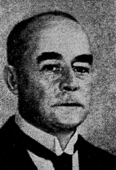Template:Did you know nominations/Willem Thomas de Vogel
- The following is an archived discussion of the DYK nomination of the article below. Please do not modify this page. Subsequent comments should be made on the appropriate discussion page (such as this nomination's talk page, the article's talk page or Wikipedia talk:Did you know), unless there is consensus to re-open the discussion at this page. No further edits should be made to this page.
The result was: rejected by Z1720 (talk) 12:57, 11 July 2022 (UTC)
| DYK toolbox |
|---|
Willem Thomas de Vogel
- ... that Willem Thomas de Vogel put his money where his mouth was and bought land for Dutch Semarang to improve living conditions for its poor, only to see the city use the area for luxury villas instead?
- Source:
- Snijders, Emilius Paulus (10 March 1953), "Hoofdartikelen: Dr. W. Th. de Vogel 90 Jaar Terugblik op een Rijk Leven", Nederlands Tijdschrift voor Geneeskunde, vol. 97, no. 12, pp. 715. "heuvelland te zoeken, waar de gezondheidstoestand veel beter bleek te zijn. Hoe logisch en vanzelfsprekend het nu lijkt, DE VOGEL heeft jarenlang met taaie volharding moeten strijden om deze eenvoudige inzichten tot gemeengoed te maken. Gesteund un voorgelicht door zijn vriend SOENARIO, later door TILLEMA en WESTERVELD, zette hij door, en risqueerde zelfs geheel belangeloos eigen kapitaal, door ten behoeve der gemeent, die nog weifelde, de vookeursrechten op de onbebouwde grond in deze heuvels van de bevolking te kopen, ten einde grondspeculatie te voorkomen. Hij legde de toegang tot Nieuw Tjandi open; de "de Vogelweg" symboliseert dit op zinvolle wijze."
- Van Roosmalen, Pauline Katherina Maria (2017), "Modern Indisch Town Planning", The Life and Work of Thomas Karsten, Amsterdam: Architectura & Natura Press, pp. 270–274. "Together with his Semarang council colleague, the medical practitioner Willem Thomas de Vogel (1863-1955), Tillema had appealed to the municipality to develop the hills south of the city for the indigenous inhabitants of Semarang... The plan never passed its preliminary stage. Although the Semarang municipality had already purchased the land, it did not perceive the hills as a suitable residential location. De Bazel's plan and, consequently, Tillema and De Vogel's ambition to develop the area, thus remained in limbo... Karsten revised the plan in 1919, in collaboration with Semarang's new Director of Municipal Housing Service, Johannes Jacobus Gerardus Everwijn Riickert. The outcome was a plan reminiscent of contemporary European town plans... Karsten's final plan incorporated the hill site south of Semarang. While earlier allocated for a new kampong, it was now allotted to an upscale and exclusive residential area."
- Source:
ALT1: ... that the founder of Indonesia's public health service, Willem Thomas de Vogel, was only able to finish med school thanks to his brother-in-law and cousin Dr. Einthoven, the father of electrocardiography?Source: Snellen, Hermann Adrianus (1995), Willem Einthoven (1860–1927) Father of Electrocardiography, Dordrecht: Kluwer Academic Publishers, pp. 22 & 70.- ALT2: ... that, when Willem Thomas de Vogel began sailing, his family forced him to take up the more respectable career of managing a cinchona plantation instead? Source: Snijders, Emilius Paulus (10 March 1953), "Hoofdartikelen: Dr. W. Th. de Vogel 90 Jaar Terugblik op een Rijk Leven", Nederlands Tijdschrift voor Geneeskunde, vol. 97, no. 12, p. 714.
- ALT3: ... that Willem Thomas de Vogel blocked any official use of traditional Indonesian medicine after he saw how poorly it handled the 1908 cholera outbreak? Source: Murakami, Saki (2015), "Call for Doctors! Uneven Medical Provision and the Modernization of State Health Care during the Decolonization of Indonesia, 1930s–1950s", Cars, Conduits, and Kampongs: The Modernization of the Indonesian City, 1920–1960, Leiden: Brill, p. 34.
- ALT4: ... that the founder of Indonesia's public health service, Willem Thomas de Vogel, fought against providing actual health care, preferring to work on improving sanitation and hygiene instead? Source: Winckel, Charles Willem Frederik (19 March 1955), "Personalia: In Memoriam Dr. W. Th. de Vogel", Nederlands Tijdschrift voor Geneeskunde, vol. 99, no. 12, p. 899.
- ALT5: ... that Willem Thomas de Vogel spent his life fighting malaria, cholera, and bubonic plague in the Dutch East Indies but lived to the age of 92? Source: Eh... See the article xD
- Reviewed: Template:Did you know nominations/Al-Wishah fi Fawa'id al-Nikah
Created by LlywelynII (talk). Self-nominated at 22:59, 7 May 2022 (UTC).
- Kindly avoid adding extraneous links to the hooks. — LlywelynII 23:02, 7 May 2022 (UTC)
 @LlywelynII: New enough and long enough. QPQ present. AGF on the Dutch hooks and offline, with ALT3 checking out. ALT1 is too long (201 characters). No textual issues.
@LlywelynII: New enough and long enough. QPQ present. AGF on the Dutch hooks and offline, with ALT3 checking out. ALT1 is too long (201 characters). No textual issues.
- Can Find a Grave be replaced in re: source for burial location?
- I really think Semarang, Willem Einthoven, and cinchona should be linked — I know I needed that context.
- I'd change "the" to "a" before "1908" in ALT3, in part because we don't have an article about this outbreak.
- Preference for hooks in order: ALT0, 4, 3, 2, 5
- Once the Find a Grave source is replaced, I will approve. Sammi Brie (she/her • t • c) 02:06, 17 June 2022 (UTC)
- @LlywelynII: ? Narutolovehinata5 (talk · contributions) 01:24, 1 July 2022 (UTC)

